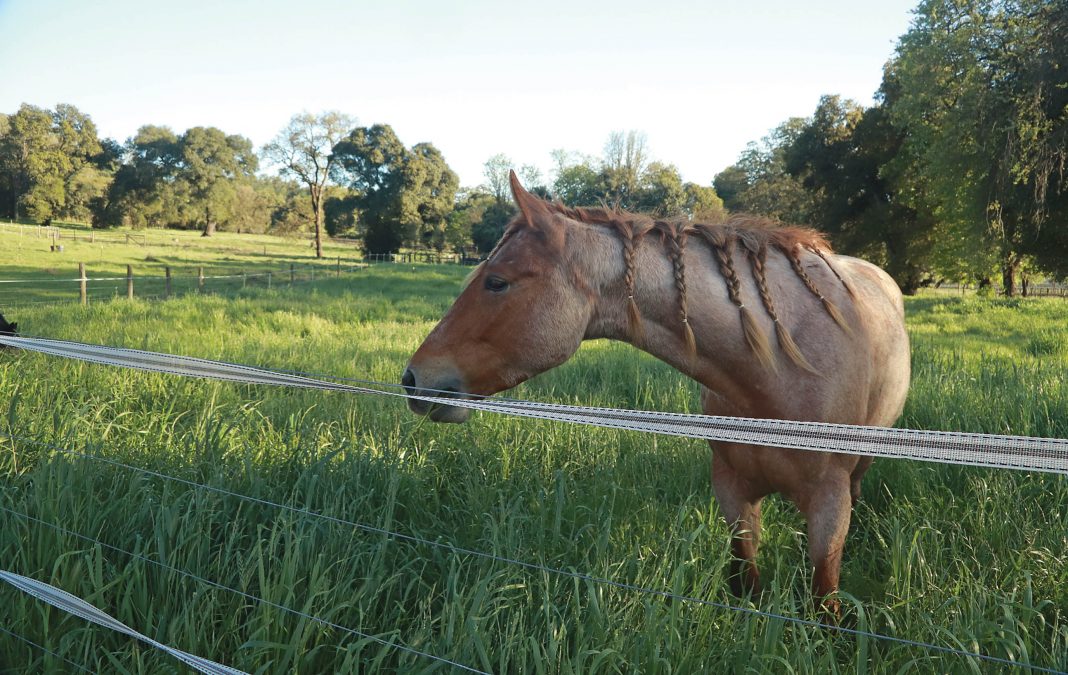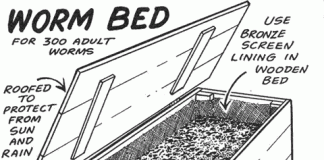By Eloise Twining
I’ve used solar powered electric fencing on my California ranch for at least 35 years. Over that time electric fencing has proved to be a very effective way of controlling stock safely. Unfortunately, it can also be dangerous, even deadly, without a few precautions. I’ve made most of the mistakes possible and now have a “safety checklist,” including: Is the fence visible? Could it start a fire? Is it working? Is it built well enough to stay standing and functional as long as it is needed?
Have you ever looked out over a field and only seen fence posts and not the wire that you know is there? Wires can become completely invisible at dusk, dawn, or on grey days when the light is behind them. The smaller the wire, the harder it is to see. Animals, including humans, have been seriously injured or killed by running full tilt into an invisible strand of wire. I’ve tripped over a low wire that I knew was there but could not see and momentarily forgot. Wire fences, especially one or two strand electric fences should always include a visual barrier.
A wooden board or pole with an electric wire run in front of it works well as a way to create a visual barrier. The downside is that it can be expensive and requires lots of posts to hold up the wood. Wood can splinter into jagged unsafe points and some animals like to snack on it.
I have seen people try and use plastic or fabric “flags” tied to the wire. They help a little, but animals may try to run in between the flags without recognizing them as marking a fence. Wind is remarkably effective at clumping carefully spaced flags together in a totally useless place.
Electric fence tape is my favorite. Tape comes in two widths: 1½ inch wide and ¾ inch wide. Both are very effective in making a fence visible. Narrow tape will carry electricity for two to six years, wider tapes up to 15 years. Eventually the tiny wires in the tape stretch until they break or rust through and the tape no longer carries electricity. On my more permanent fences I run a piece of tape purely as a visual aid, along with a wire to carry the current. The combination can work for decades until the sun rots the vinyl and chafed spots turn the tape into a patchwork of knotted repairs.
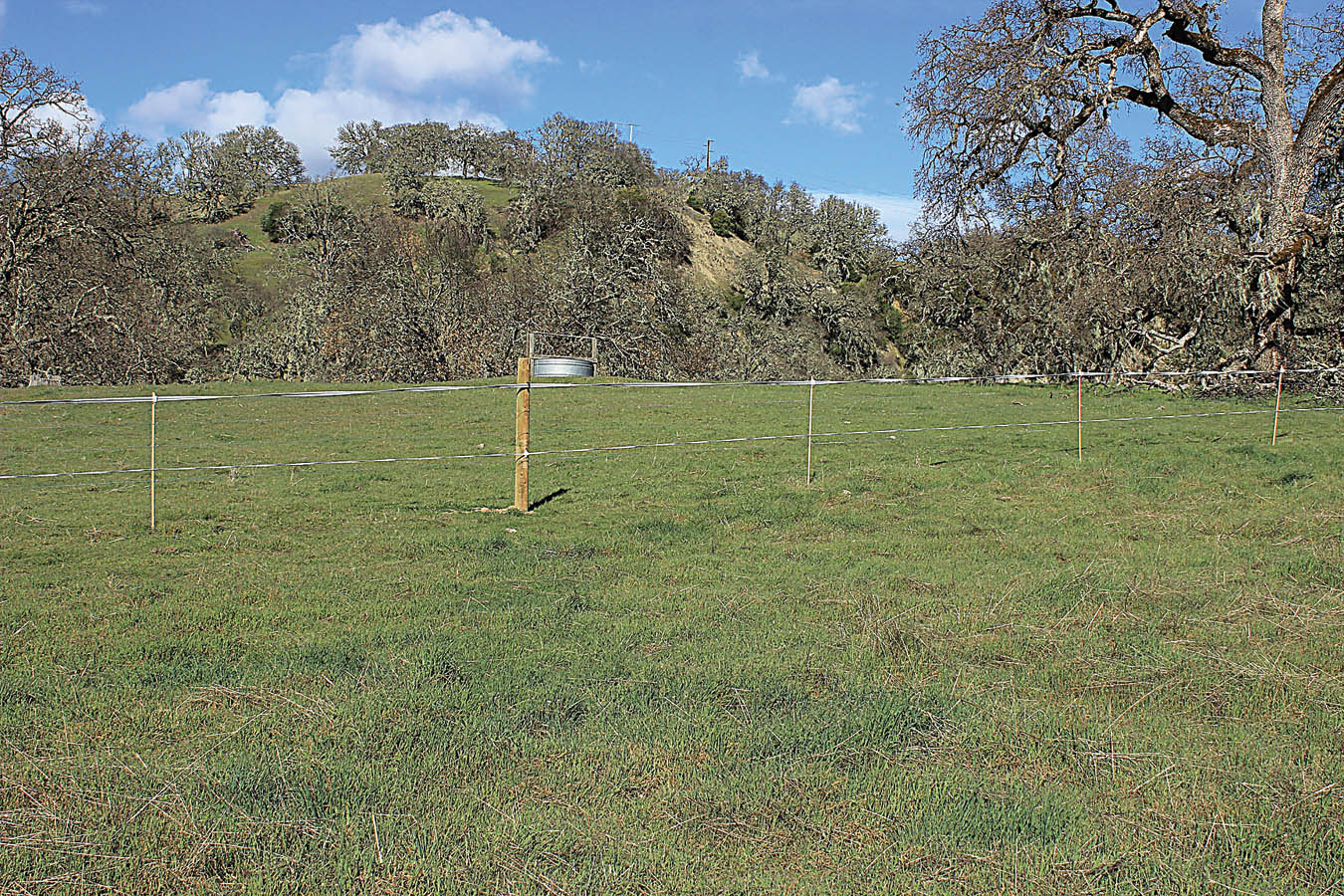
Electric fence tape is easier to see than wire.
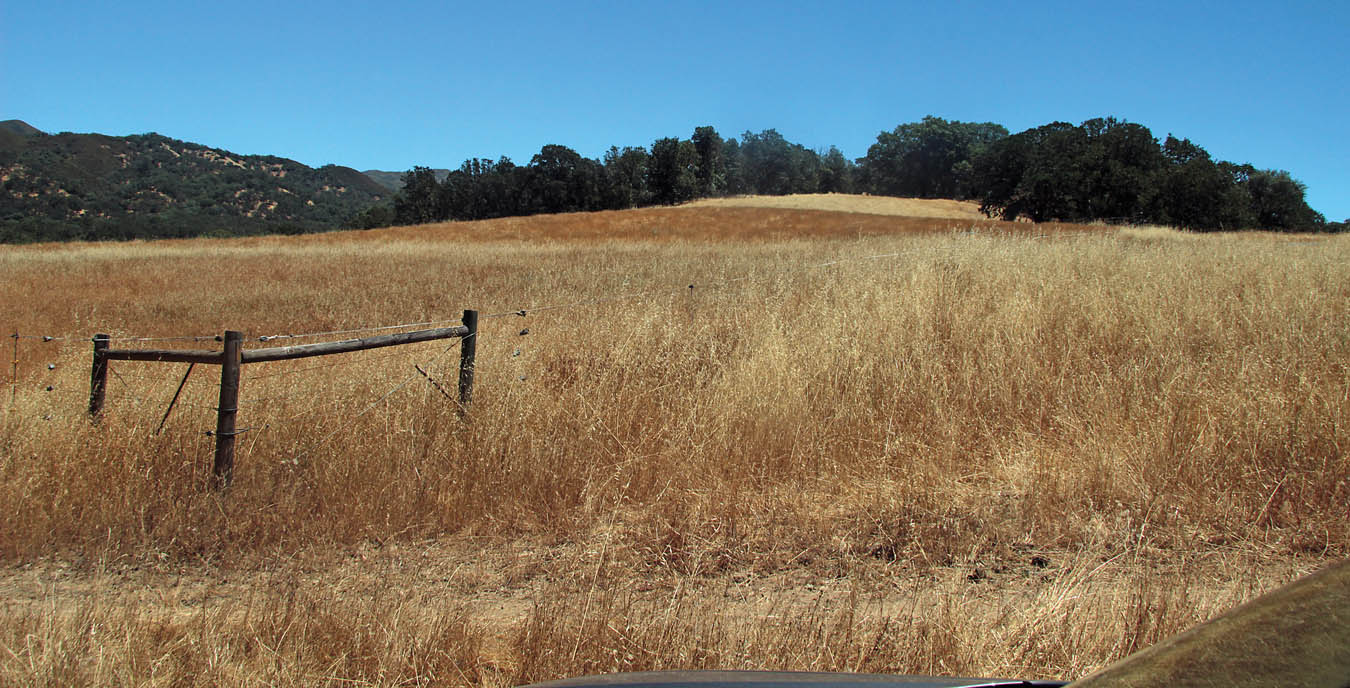
A well-supported fence is a safer fence. Corner braces keep the fence tight.
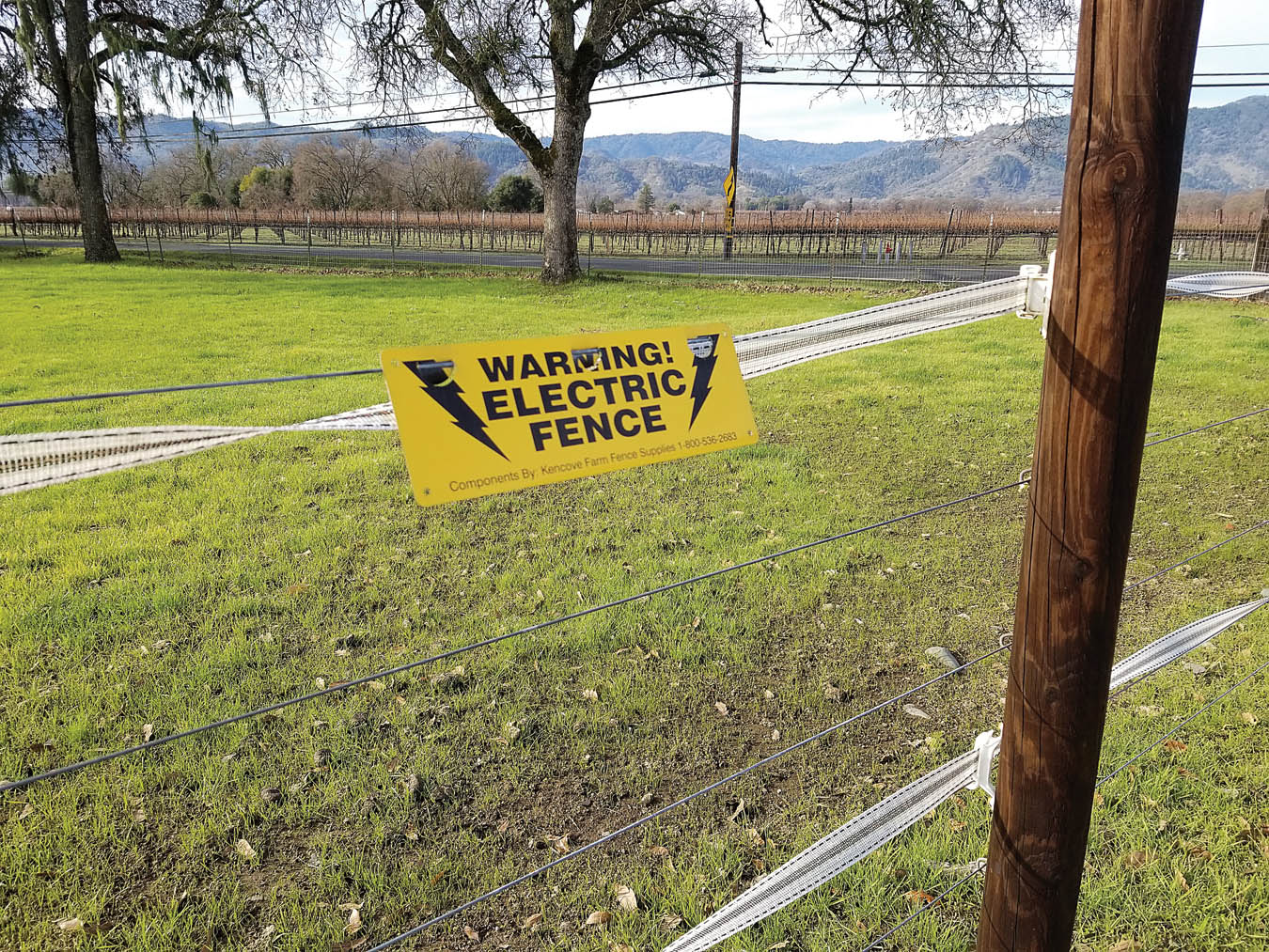
Another way to make your fence more visible is to use warning signs.
A piece of flat tape is a tiny sail — wind, even a breeze will make the tape flutter and saw back and forth the insulators. To greatly reduce wind damage, put a 180 degree twist in your tape between every post. In some areas moss grows through the tape reducing its visual, and sometimes electrical effectiveness. Check shady damp areas yearly for this issue. Like most things, all tape is not created equal. Check manufacturers’ claims for tape life, it varies a lot. Well-made tape does indeed last many years more than the cheap stuff. Electric rope is very similar to tape and can be a great temporary fence solution. It is bulkier than tape if you plan to store it in off seasons, and it doesn’t work well on the handy reels that are made for tape storage. Rope lasts a little longer than tape, with some manufacturers claiming their rope will last 20 years. On my place, 10 years is more realistic. All the rope I’ve worked with has been quite UV sensitive and has chafed badly. Like tape, check the expected life before you purchase. I don’t use electric twine as it does not provide a visual barrier under many conditions.
A tight, well supported fence is a safer fence. Poorly supported fences often sag, inviting wires to fall out of insulators, tape to gain momentum and saw back and forth in insulators, and animals to crawl through the fence. I remember one occasion when one of my temporary fences came loose, leaving coils of tape and wire on the ground. One of the horses got tangled in it and was unable to move. I was extremely fortunate the loops had come loose from the fence charger and didn’t shock the mare. She just stood there for several hours and waited for someone to help her. If she had struggled she would have cut herself to pieces and probably would have had to be put down. Inspect your fence regularly to make sure everything is secure, tight, and that there are no frayed spots that could break.
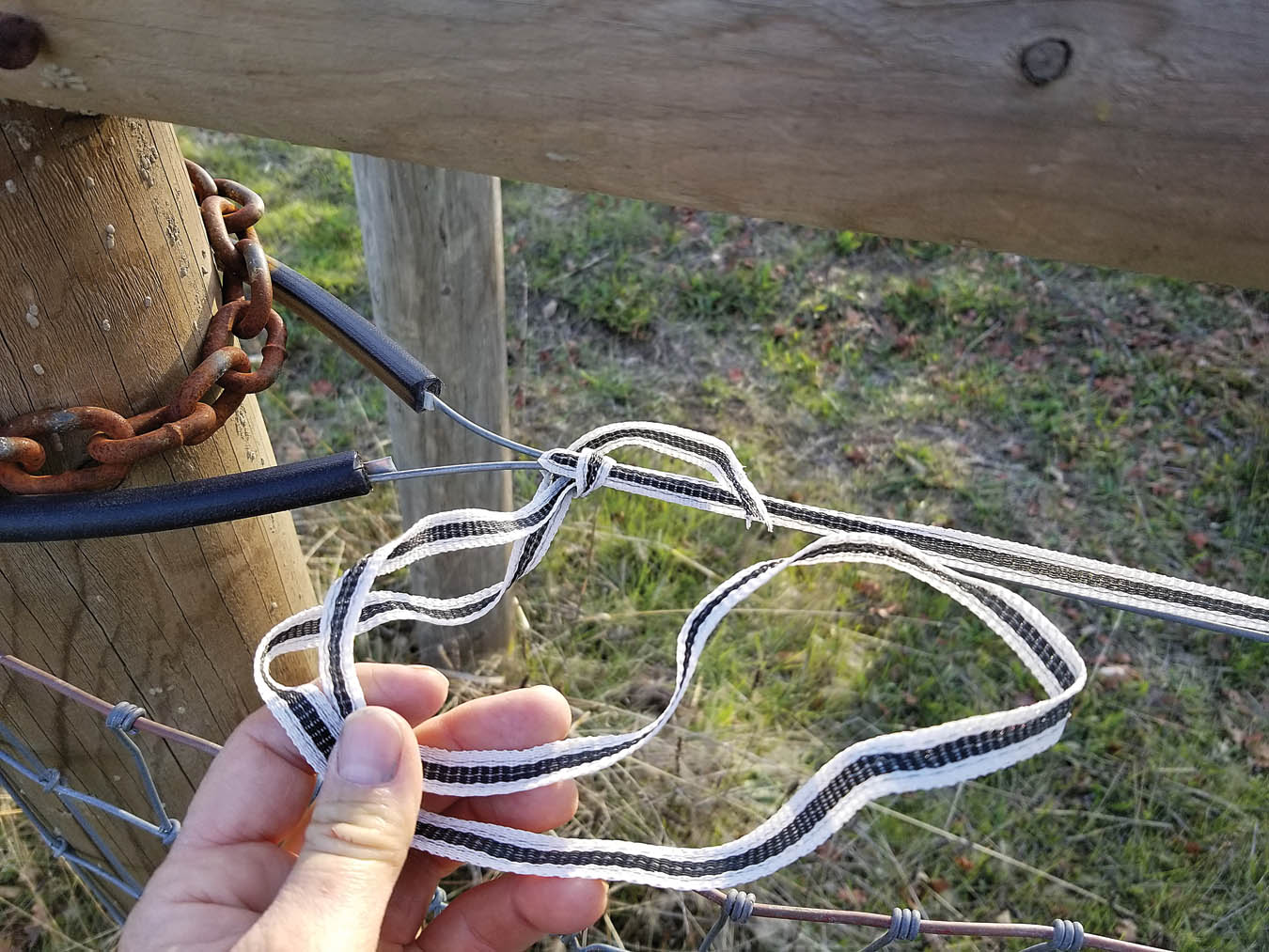
Beginning knot: Put your fence tape through whatever insulator you are using at the end of your fence. In this case it is a loop of wire that goes around the post through some insulating tubing. Form a loop, and pass the loop around the working strand of tape and up under itself forming a slipped half hitch. Do not pull the loop through. Leave a short “tail” and continue to do regular half hitches around the tape with your loop. The regular half hitches should be a little loose so you can undo them easily if you need to tighten the tape or do a repair. When you undo the knot and get down to the slipped-half-hitch simply pull the tail of the tape and the knot will be undone. It saves lots of time you would otherwise spend muttering at the knot and trying to undo that last bit!
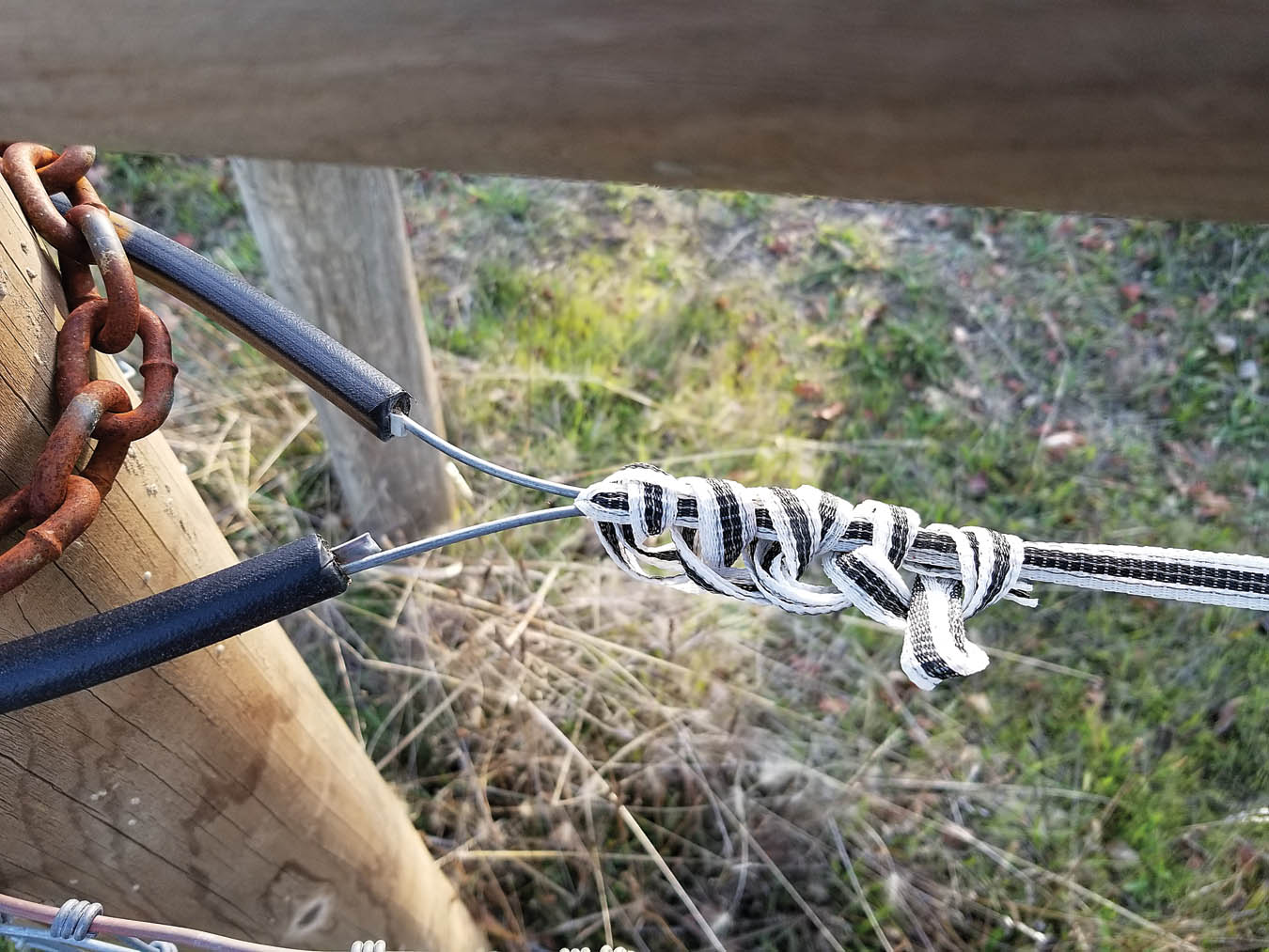
Finished knot: Here is the finished product, neat, nothing to dangle down and short out on another wire or post.
A word here about knots — my go-to knot to secure a piece of tape starts with wrapping the tape twice around the end insulator and tying a slipped-half-hitch. This knot allows you to quickly undo the end of the tape, tighten the fence, and re-secure it without endlessly picking the knot apart. To finish securing the tape I fold three or four inches of the tail of the tape back along the working tape. The loop formed by the slipped part of the knot is used to do one or more loose half-hitches around the working line and the tail. Do not pull the secondary half-hitches particularly tight.
Never use electricity in confined spaces such as a small pen. Panic caused by a electric shock can cause injuries, especially if the animal cannot move far enough away to feel safe.
Most people do not think about a fence post as a hazard, but any post can be dangerous. Metal T-posts are probably the worst. They can impale a playful or nervous animal, especially horses. My vet says she sees several T-post wounds a year. White plastic mushroom-shaped post caps help reduce this danger. Caps are relatively cheap and hundreds of times less expensive than the cheapest vet bill. The best caps have a built-in clip for electric fence tape/rope/wire and fit tightly on the post. If you have a wire fence with T-posts, it is worth putting a cap on each post and running electric tape or rope through them. The electric strand will help keep animals from turning the T-post caps into playthings, and the tape will help give the fence visibility.
When I patrol a fence, I listen for a “snap” sound. That snap is a spark jumping from the fence wire to something else. Sparks can jump an amazing distance — I’ve watched one bridge an inch-wide gap. This is bad enough when the spark is shorting out your fence and draining your solar battery, but it is worse when there is fire danger. The more secure your electrical connections are, the less likely problems will occur. Where wires connect, such as next to a gate or in corners, a device like a split bolt is essential to holding them tightly together. The common practice of twisting one wire around another to form a junction risks a poor connection. If such a twist loosens up over time or even starts to rust away, you risk a spark or a poorly working fence. It goes without saying that flammable items like dead grass should be kept away from the electric system as well.
Gates are a whole bundle of trouble. I have a lot of gate openings where the electric wire runs underground across the gate. I learned the hard way to always run ground rated, double insulated wire under gates. I have a strong preference for solid wire, not multi-stranded wire which is much harder to work with and not as durable. I run my double insulated wire inside a piece of old black plastic pipe as extra protection from rodents and rocks. A couple of decades ago I tried running plain, non-insulated fence wire under a couple of my gates. To insulate and protect the wire I put it inside PVC pipe. I even formed a U shape at the top of the pipe to keep rain out. About five years later the fence wasn’t working, and hadn’t been working well for a while. I dug up the PVC to find one of the underground elbows completely melted where the wire had rusted out and electricity had sparked across the resulting gap. The cause? Underground temperatures are almost always different from above ground temperatures causing condensation in the pipe. This happens even in otherwise arid conditions. A consistently damp or wet environment inside a pipe rusts non-insulated wire out amazingly fast. If my pipe elbow had been just an inch higher I could have started a devastating wildfire. None of my double insulated ground rated wires have ever had a problem.
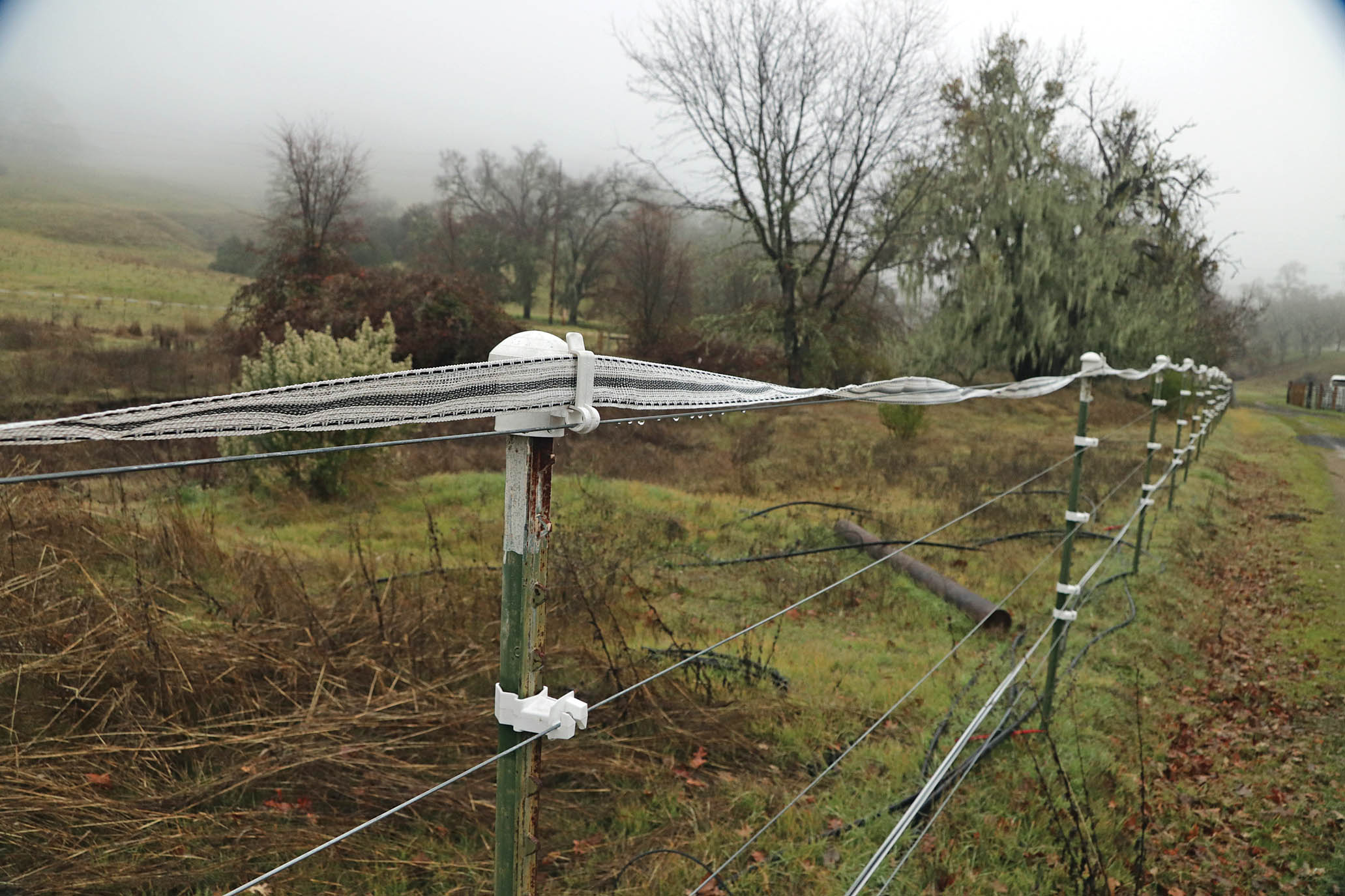
Plastic post toppers can help to reduce injury of playful animals.
Run the end of your under-gate wire straight up to your top electrical strand before making a connection. This should keep your electrical connection above the top of the grass and at a handy height to work on. In my permanent installations I put a knife switch at that junction. Knife switches are used to turn on and off the flow of electricity. They help isolate sections of fence and speed troubleshooting up a huge amount. A well-placed knife switch can save miles of walking while you troubleshoot, and also allow you to turn off unused pastures.
My fences have two electric strands, one high and one low. Once I have connected up the top strand with a knife switch I install a second switch on the other side of the H brace that turns the lower wire on and off. That way I can easily turn off the lower wire when spring grass grows up into it and grounds the system out. Placing the knife switches on opposite sides of the H brace lets you easily see which switch is open or closed from a distance.
Materials like double insulated wire, split bolts and knife switches do cost money. They will pay you back many times over by reducing the time you spend troubleshooting and fixing problems, and they will keep your fence safe by keeping it working correctly.
Electric fence gates made out of tape, wire, or rope should get their electricity from the side you open the gate from. Once you unhook them from the gate post, the gate should not have power. Just thinking of an animal caught in loose gate wire and getting shocked scares me, not to mention shocking yourself, or sparking to the ground!
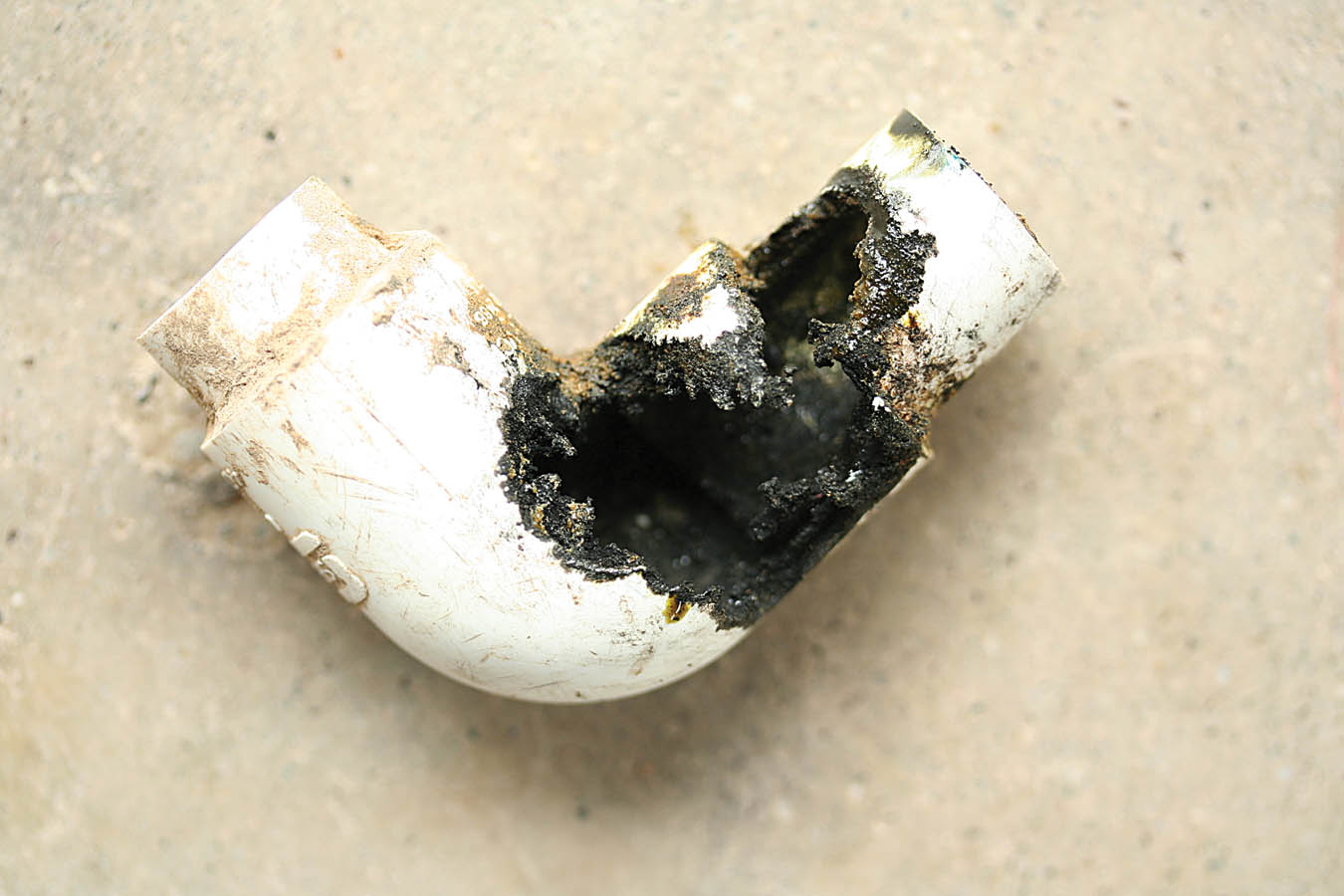
I learned the hard way to always run ground-rated, double-insulated wire under gates.
Is this thing on?
Fences are only safe if they work. Animals quickly learn to hear the click of a fence charger on the line and they love to challenge the fence when the charger isn’t working. Any animal can become tangled in tape, rope, or wire while walking through and knocking down a non-functional fence, even if it is safe when working properly. Clever escape artists just knock the fence around, creating a big repair job and turning up where they shouldn’t be. Even if the charger is working the fence can be non-functional if something like green grass gives the electricity a path to ground.
In very dry conditions when the ground has completely dried out, and sometimes even in frozen snow, electric fences don’t produce a shock. There are ways around this which are outside the scope of this article. Check your electric fence frequently with a fence tester to make sure that it will actually create a shock.
Electric wires have to be installed at the correct height to work and keep animals in safely. A full size horse needs two strands, one at about four feet to keep them from leaning on the fence, and one at about two feet to keep them from stepping through or crawling under the top wire. A young pig wouldn’t even notice wires at those heights: they need one at nose height and one or two additional strands above that so they can’t just step or jump over it. Cows respect my lower wire which is at their face height but they never notice the top wire. So position your wires and space them so they will work with your animals. A fence is only safe if it actually keeps your animals in, and does not let them out on the road.
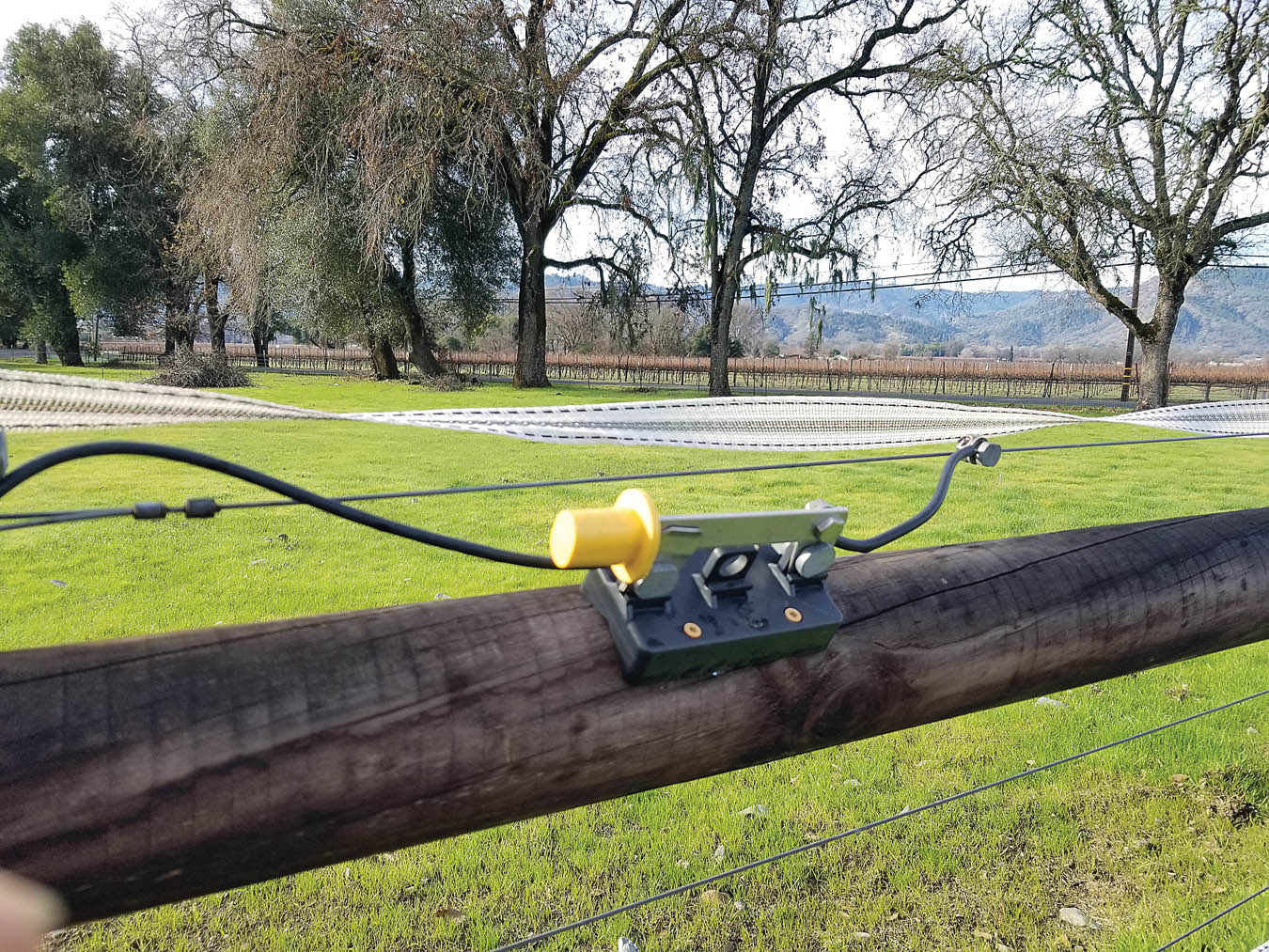
This picture shows a knife switch attached to the under-the-gate wire and to the top wire of the fence. The split bolt attachment is clear, and the 1.5″ tape above it shows a lovely wind defeating twist.
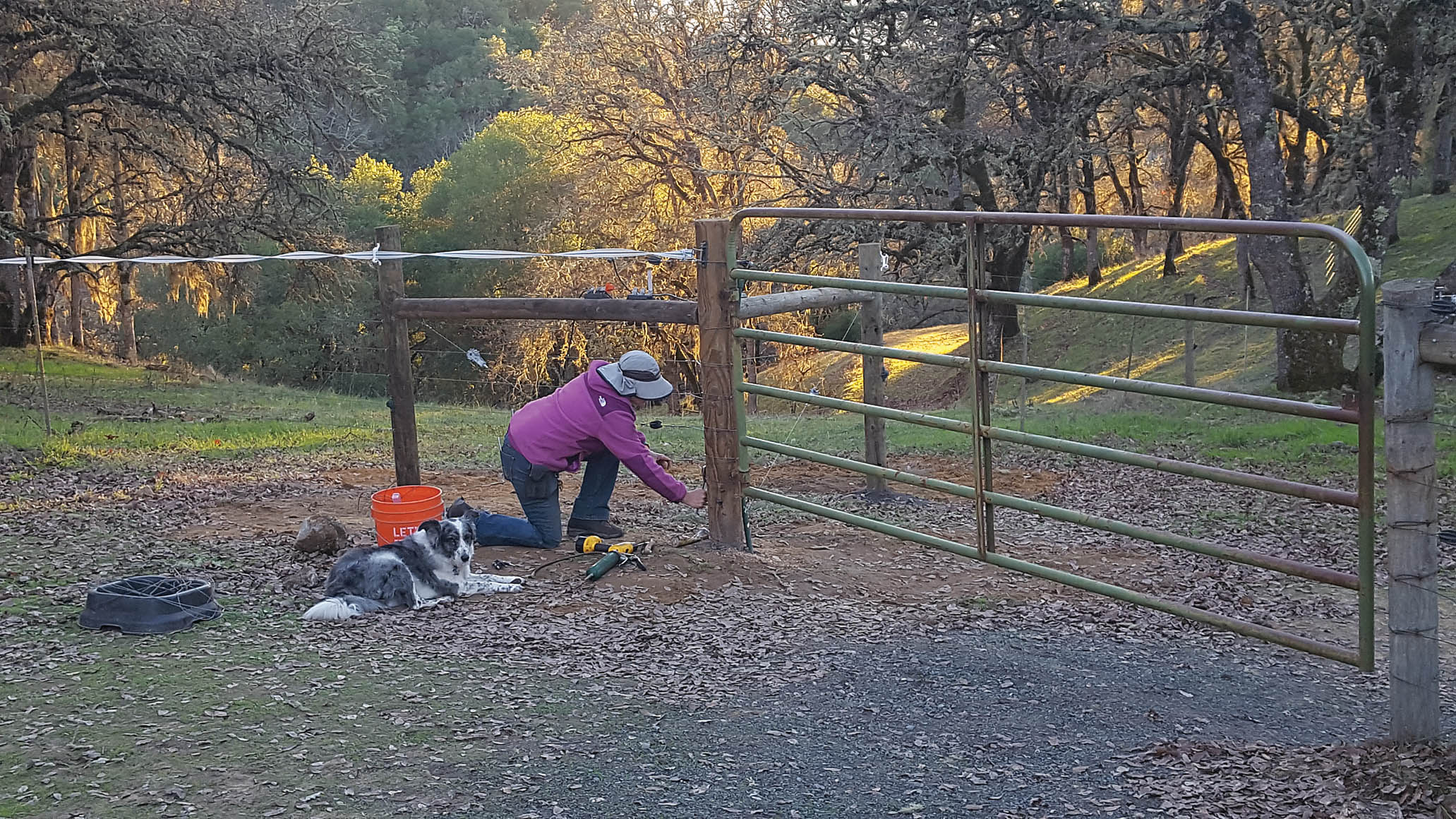
I have a lot of gate openings where the electric wire runs underground across the gate. I run double insulated wire inside a piece of old black plastic pipe as extra protection from rodents and rocks.
To keep people safe, make it obvious that your fences are electric. A few years ago I bought a handful of signs saying “electric fence” and hung them on my fences at the barn and along a public road that borders my fields. Not only could someone sue me for not marking my fences, a shock could be extremely dangerous to a child or to someone with heart trouble.
With just a little care and attention to detail, electric fencing can be a highly effective, very safe, flexible way to keep livestock in the right pasture. Just make sure it is working, visible, tight, and fire safe!
Eloise Twining is the owner Twining Pastures, a rugged 1,500 ranch 100 miles north of San Francisco. She has spent the last 45 years building and maintaining fences. Her website is www.twiningpastures.com.


